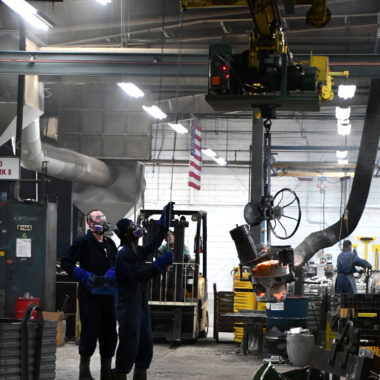Crafting Brilliance: Browsing the World About Aluminum Casting
Crafting Brilliance: Browsing the World About Aluminum Casting
Blog Article
Crafting Excellence: Exactly How to Achieve High-Quality Light Weight Aluminum Castings Every Time
In the world of light weight aluminum spreading, the search of excellence is a constant journey that needs a careful strategy and an eager understanding of the details involved. Achieving constant top quality light weight aluminum castings demands an extensive understanding of the procedures, from picking the proper alloy to performing precise mold designs and carefully managing spreading parameters.
Comprehending Aluminum Spreading Processes
Light weight aluminum casting processes, necessary in the manufacturing sector, entail the intricate change of molten aluminum into solid forms through a series of carefully controlled actions. Understanding these processes is critical to attaining high-quality light weight aluminum spreadings constantly - about aluminum casting. The key techniques utilized in light weight aluminum casting are die spreading, sand spreading, and financial investment spreading

Each of these processes has its advantages and is chosen based on aspects like intricacy, quantity, and preferred surface of the light weight aluminum spreading. about aluminum casting. Recognizing the details of these approaches is crucial for makers aiming to create premium aluminum castings constantly
Picking the Right Light Weight Aluminum Alloy
Choosing the proper aluminum alloy is a crucial choice in the manufacturing of premium light weight aluminum castings. The selection of alloy substantially impacts the properties and qualities of the last item. Different aluminum alloys offer differing levels of strength, corrosion resistance, machinability, and thermal conductivity. When selecting a light weight aluminum alloy for casting, it is necessary to take into consideration the details demands of the application to ensure ideal efficiency.
One of the most typically made use of light weight aluminum alloys for casting is A356 - about aluminum casting. For applications requiring high toughness, 7075 light weight aluminum alloy is a popular option due to its outstanding strength-to-weight proportion.
In enhancement to mechanical residential properties, factors to consider such as price, schedule, and post-casting procedures must also influence the choice of the best aluminum alloy. By thoroughly examining these variables, suppliers can make certain the manufacturing of top notch light weight aluminum spreadings that satisfy the preferred specifications.
Implementing Proper Mold Style
Establishing an effective mold and mildew design is crucial for ensuring the effective manufacturing of top notch light weight aluminum castings. Correct mold and mildew style plays a considerable function in achieving the wanted attributes of the final item. To apply an effective mold and mildew design, factors such as product flow, cooling down prices, and part geometry have to be carefully thought about.
One secret aspect of mold and mildew design is guaranteeing correct filling and solidification of the aluminum within the mold and mildew tooth cavity. This involves making runner and gating systems that promote smooth metal circulation and avoid issues such as air entrapment or incomplete dental filling. Additionally, incorporating air conditioning channels right into the mold and mildew style helps regulate solidification rates and lower Full Report the risk of porosity or shrinking defects.

Controlling Casting Parameters

Making Certain Post-Casting High Quality Checks
To preserve the high quality of light weight aluminum castings, detailed post-casting high quality checks are vital. After the casting procedure is completed, it is critical to guarantee that the last items meet the preferred specifications and requirements. One of the key quality checks entails examining the surface area finish of the spreadings to identify any type of issues such as porosity, cracks, or surface abnormalities. This aesthetic evaluation is usually supplemented by non-destructive testing techniques like ultrasonic testing or color penetrant assessment to detect internal visit the site flaws that might compromise the honesty of the casting.
Dimensional accuracy is one more vital element that must be confirmed during post-casting high quality checks. Measurements of crucial dimensions and resistances should be taken to verify that the castings conform to the required specifications. Furthermore, mechanical residential properties such as solidity, tensile strength, and impact resistance may need to be evaluated via product testing to make certain that the spreadings have the needed stamina and durability for their designated application.
Final Thought
In final thought, accomplishing top notch aluminum castings requires a comprehensive understanding of the casting procedures, picking the appropriate alloy, making mold and mildews efficiently, controlling spreading criteria diligently, and carrying out post-casting high quality checks diligently. By adhering to these actions, manufacturers can continually create aluminum spreadings that satisfy the greatest requirements of quality and efficiency.
Achieving regular premium light weight aluminum spreadings demands a comprehensive grasp of the procedures, from choosing the ideal alloy to carrying out precise mold and mildew designs and meticulously regulating casting criteria. The primary approaches utilized in light weight aluminum casting are pass away casting, sand spreading, and investment spreading.
Investment spreading, also understood as accuracy spreading, includes creating wax patterns that are coated in ceramic to create molds.Choosing the appropriate light weight aluminum alloy is a crucial choice in the manufacturing of premium light weight aluminum castings.Making sure precise control over casting specifications is essential for preserving uniformity and quality in aluminum casting manufacturing.
Report this page